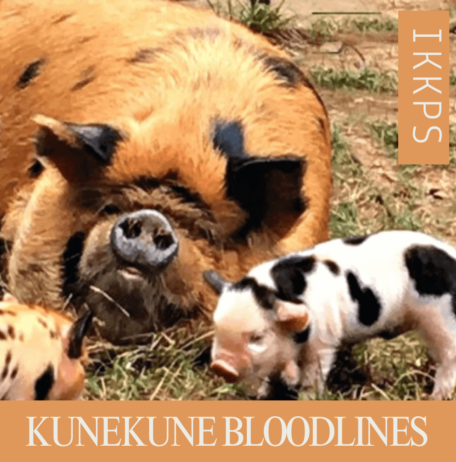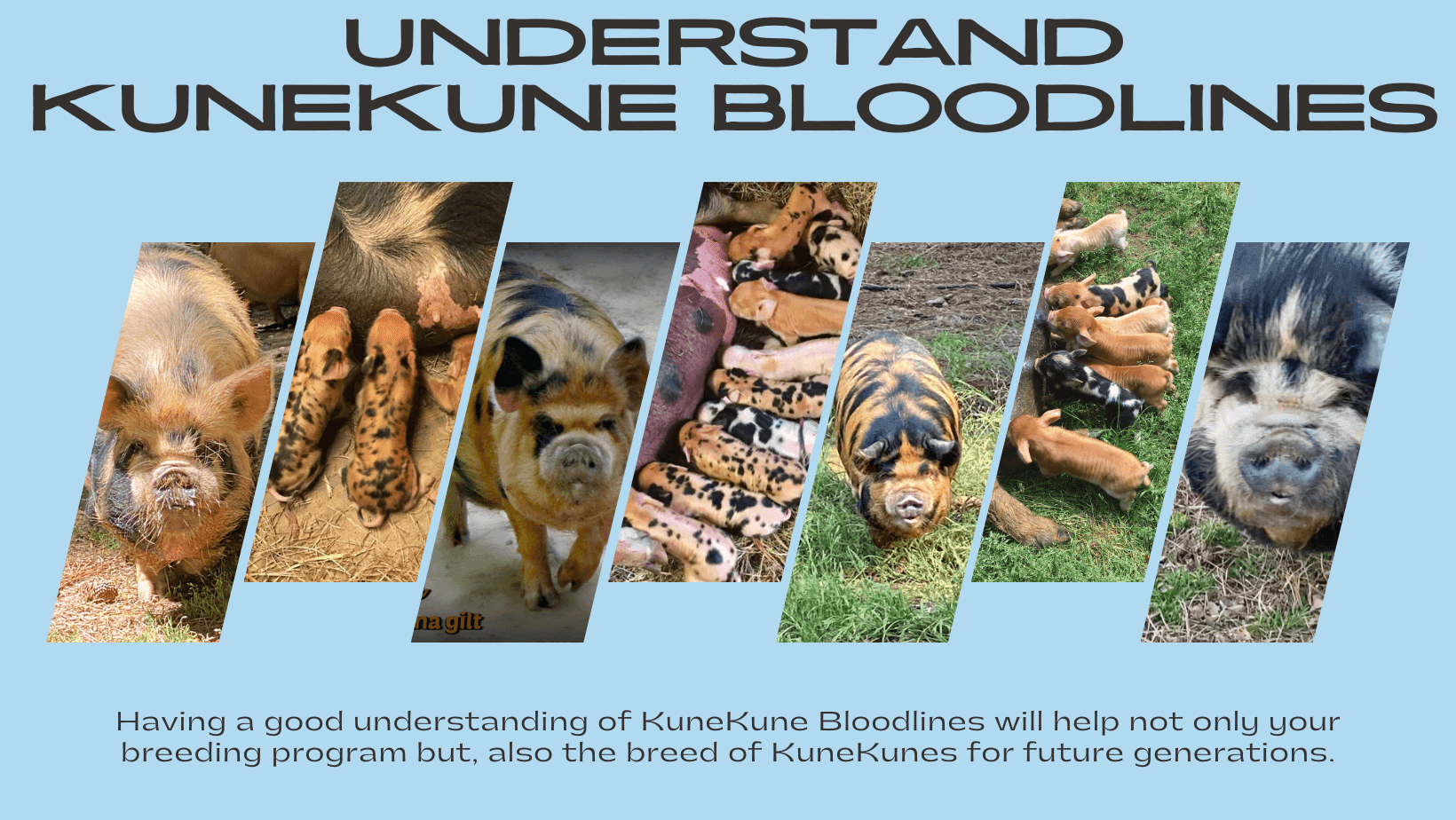
JOIN US
GET OUR KUNEKUNE
NEWSLETTER
New and highly discounted products, fresh and hot stories & useful information
KuneKune Research
KuneKune Bloodlines
In-depth research was done on the KuneKune Bloodlines in 2011 by Kathy Petersen. Utilizing the New Zealand Herd Book, and the UK Herd Books, the first 2 AKBA herd books to bring you the most comprehensive listing of the USA and Canada Bloodlines. Learn what they were and if they were renamed.

Click the link to be directed to these topics on the page.
KuneKune Bloodlines - Learn more
One of the topics that attracted me to the breed was the history as I have mentioned before. To breed these wonderful pigs, I wanted to know how they were tracked by the original New Zealand 18 pigs if they were at all. It was a labor of love and so many hours went into doing this. Tracing backwards. First, tracing from the USA registry. Second, through the UK and finally arriving back in New Zealand. Thanks to a fellow KuneKune breeder, I had all the New Zealand Herd Books.
How does the USA have more KuneKune Bloodlines than any other country?
This is quite simple to answer. First, KuneKunes were imported into this country. There have been several imports. The first KuneKune Registry would allow for KuneKune that were imported to be given a new bloodline name. It was up to the importer what names they picked. As a result, their original bloodline (if any) was lost and without the research done, we would never know. Therefore, with the renaming tradition, it is important to know what they truly are.
List of KuneKune Imports
This is an amazingly simple listing of the Imports. On mobile devices, it is easier to view on a desktop.
KuneKune Imports | Year | Bloodline | Boar or Sow Line | What Country |
|---|---|---|---|---|
Katie Rigby | 1995 | Tonganui Boris | Boar Lines | New Zealand |
Katie Rigby | 1995 | Rona Wilsons Gina | Sow Lines | New Zealand |
Lori Enright | 2005 | Andrew Te Whangi | Boar Lines | United Kingdom |
Lori Enright | 2005 | Jenny | Sow Lines | United Kingdom |
Sue Drake | 2010 | Tutaki | Boar Lines | United Kingdom |
Sue Drake | 2010 | Rebecca Gina | Sow Lines | United Kingdom |
Tule Fog Farm | 2010 | Mahia Love Tutanekai Tuahuru Whakanui | Boar Lines | New Zealand |
Tule Fog Farm | 2010 | Aria Giana Tapeka Tarutaru Momona Haunene | Sow Lines | New Zealand |
Matt Burton/Christopher Rowley | 2012 | BH Tutaki Ru | Boar Lines | United Kingdom |
Matt Burton/Christopher Rowley | 2012 | Sally BH Rebecca Gina Kereopa Trish Awakino | Sow Lines | United Kingdom |
2022 Imports
Yes, now there is another import. Again, from the United Kingdom. This import contains fifteen piglets and was imported by Libby Milroy of DuckDawg Creek. These are repeated lines but will be a bit different genetically as they have been paired differently. There are a few Sally's, Rebecca Gina's, Jenny's, Kereopa's, Trish's, Awakino's, Tutaki's, Ru's, and Andrews. Of course, these are well-established lines already here.
It is my understanding that they will not get a new bloodline but, they will be marked as DDC Awakino or DDC Tutaki. These imports will not have parentage DNA reports as the British KuneKune Pig Society does not require DNA testing for registration purposes like the USA and Canada registries. As a result, we must assume they are of those bloodlines.
It is my understanding that all registries will be accepting them. Consequently, this is surprising for AKKPS as they are not parentage verified but, since this is the first opportunity, they have ever had for imports to start in their organization, this may be why they have decided to bend their own rules. I have not seen a membership vote on it, we can only assume it was another Board of Director's decision. They will have permanent genetic marker DNA testing completed as a beginning DNA source for further offspring parentage verification testing.
Embarking on a journey through the bloodlines of KuneKune.
Breeding KuneKune pigs requires a complete understanding of the various bloodlines. Each bloodline carries certain traits that can affect the quality and characteristics of the offspring. For instance, the Jenny and Wilsons Gina line is renowned for its exceptional mothering abilities. In KuneKune breeding, a bloodline refers to the lineage of a pig. These bloodlines are named after the boar or sow, and these names are passed down from parent to offspring based on their sex. The male piglets will follow the sire’s bloodline and the female piglets will follow the dam (sow’s) bloodline.
Let us say that you have a Trish sow that was bred to an Andrew boar. All the male piglets will be Andrews and all the female piglets will be Trish. Now let us take that a bit further. If you want to understand what Te Whangi / Jenny means – That means it is a male piglet with a Te Whangi sire and a Jenny sow is the mom. Likewise, if you see it reversed: Jenny / Te Whangi. That means it is a female piglet with a mom that is from the Jenny line and the sire is a Te Whangi boar.
Genetic Diversity in KuneKune Pig Breeding: A Crucial Element
As pig breeding practices progress, it becomes increasingly important to maintain genetic diversity within the KuneKune population. Let us talk about the significance of genetic diversity in breeding KuneKune pigs by discussing its impacts on health, adaptability, and future sustainability.
Improved Health
Genetic diversity plays a pivotal role in enhancing the overall health of the KuneKune pig breed. With a diverse gene pool, the probability of various diseases or genetic disorders decreases significantly. Inbreeding or excessive line breeding can result in a decreased ability to combat diseases, increased susceptibility to genetic disorders, and reduced reproductive efficiency. By incorporating diverse genes, breeders can minimize the risk of harmful genetic mutations and maintain a healthy and robust population of KuneKune pigs.
Adaptability to Environmental Changes
Genetic diversity is vital when it comes to ensuring that KuneKune pigs possess the necessary traits to adapt to changing environmental conditions. Climate change, global warming, and other environmental factors are impacting various regions worldwide. By breeding KuneKune pigs with a wide range of genetic characteristics, breeders can produce animals better suited to variable environmental conditions. Genetic diversity offers a chance for the breed to combat new challenges and thrive in different climates by possessing traits such as heat tolerance or resistance to certain diseases.
Preservation of Unique Characteristics:
Preserving the unique characteristics of the KuneKune pig is another crucial aspect that genetic diversity helps to maintain. Through careful breeding practices,
including outcrossing with unrelated individuals, breeders can safeguard the distinct traits of the KuneKune breed, such as their compact size, docile temperament, and exquisite coat patterns. By doing so, they help to prevent the loss or dilution of these desirable features, ensuring the preservation of KuneKune's heritage.
Future Sustainability
Promoting genetic diversity in breeding KuneKune pigs is essential for the breed's long-term sustainability. A limited gene pool can lead to a population lacking variation, resulting in a reduced ability to adapt to changing environments and increased vulnerability to diseases. This situation may threaten the survival and
viability of the breed. By actively maintaining genetic diversity, breeders contribute to the resilience and longevity of the KuneKune pig breed, safeguarding its future for generations to come.
Genetic diversity is a fundamental aspect of breeding KuneKune pigs. By emphasizing genetic variation, breeders can improve the overall health, adaptability, and
sustainability of this unique breed. Through careful breeding practices, they can safeguard important traits, promote disease resistance, and ensure continued success in various environmental conditions. Consequently, prioritizing genetic diversity guarantees the longevity and prosperity of the KuneKune pig breed and the preservation of its distinct attributes.
Unraveling the Riddle of KuneKune Bloodlines: Its Impact on Breeding Choices

To make informed breeding decisions and select the right breeding pair, it is important to have a solid understanding of KuneKune bloodlines and what your goals are for breeding. Do you want to produce meat pigs? Are you producing for selling breeding stock? It is important to note that in today’s KuneKune world, the bloodline has been mixed throughout the pedigree. In general, the most influence in a pedigree is usually the first through the third generation. So, you will want to fully understand those KuneKune Bloodlines by looking in your KuneKune Registries Herd Book.
For instance, if you are looking to breed pigs with strong conformation and mothering abilities, the Jenny line is a great option. However, if you want to preserve a rare line like BH Rebecca Gina, which is known for its larger litter sizes, incorporating the BH Rebecca Gina bloodline into your breeding program is the way to go.
Overall, a thorough understanding of KuneKune bloodlines is essential to successful breeding. With careful selection and informed breeding decisions, we can ensure
the preservation of this amazing breed's diversity and quality.
The Fascinating Origins and Heritage of KuneKune Bloodlines
KuneKune, a breed that hails from New Zealand, has a rich and diverse history that goes back several centuries. The Māori people, who raised them, called them "fat and round," which is the English translation of "KuneKune," due to their unique body shape. The Māori tribes free-ranged these pigs and they naturally stayed close to
their tribal homes. Some believe this is one of the reasons that this breed is so friendly and docile to humans. The Māori people used their fat to preserve food and utilized the pigs as meat pigs.
It is important to note that with poor record keeping some of the bloodlines were either renamed later or lost. Some of these like the Te Kuiti line are believed to have become the Te Whangi line. Also, in the UK several lines were renamed by Long Ash Farm, Andy Case. Now to confuse you a bit more, when certain lines were imported into the USA, the importers often were allowed to create a different name for the bloodline.
Some Examples of KuneKune Bloodline Name Changes
An example of this was Aria Giana. The Aria Giana and the Wilsons Gina were the same lines, however, to represent the possible genetic diversity between the two lines, the name was changed.
Another example of this is the Andrew line was imported from the UK. Renamed from Mahia Love. So, the Andrew line was originally a Mahia Love. Later came Tutanekai which is a Mahia Love as well and is one generation closer to the original Mahia Love than the Mahia Love that was released earlier.
Were some bloodlines lost? Or were they changed to another name?
Some of the lines that were lost were Waitomo but, in the tracing, two lines of ancestors go on into the Sally line. So were they lost? Not really! The Marakopa line was one of the original lines and it seems through tracing through the generations to go to the Rebecca Gina which of course links to the Wilsons Gina line. Kopu line also
seems to go into the Rebecca Gina as well.
For more information, you can check out our Deep dive into the Bloodlines eBook that spells all of this out.
Glimpsing into the fascinating future of the KuneKune Bloodlines
Breeding and pairing can cause changes in the characteristics of the bloodlines. While it is a tradition to keep the bloodline names the same from parent to offspring, it is important to consider the characteristics of each particular line. Although Jenny is still known for being an excellent mother, the ancestry of her offspring will be influenced by the sire side of the pedigree. Therefore, it is necessary to consider the breeding history of a Jenny sow to understand the characteristics of her
offspring.
The future of the KuneKune breed is strong. Being marketed heavily as the preferred pork animal will continue this breed for many years to come. However, it is
important to note that with every breeding program, their goals and understanding of the breed standard will vary and slightly change the breed. Each breeder will impact the long-term characteristics of the breed. Careful planning of breeding pairs, genetic diversity, health considerations, and adhering to the breed standard will be crucial for the longevity of the breed.
Frequently asked questions:
What is a Bloodline?
In KuneKune breeding, a bloodline denotes the lineage of a pig tracing back to its original ancestors, named after the boar or sow from which they descended. It
is a “name” given to a particular line.
Why is it important to understand bloodlines when breeding KuneKune pigs?
Comprehending KuneKune bloodlines is essential for breeders as it guides them in selecting the right foundation stock, and the right pairings by focusing on specific lines for desired traits, preserving breed diversity, and improving herd quality.
Who keeps the records of the lineage?
The maintenance and tracking of KuneKune bloodlines are the responsibility of breed registries such as the International Kunekune Pig Registry. These breed registries hold the responsibility of recording pedigrees and preserving distinct bloodlines. They do this when you register pigs with them.
What does genetic diversity mean?
Genetic diversity refers to the variation and differences in the genetic makeup of individuals within a population and among populations of the same species. Genetic diversity is crucial for a species' survival and adaptability. Higher genetic diversity increases the chances of individuals possessing genetic variations to survive despite environmental challenges.
Why is it important to maintain genetic diversity?
KuneKune breeding requires the maintenance of a broad genetic base, making genetic diversity a critical factor. Many bloodlines that we have come from 18 original
pigs. Preserving this diversity is essential, which is why selecting pigs from multiple bloodlines is highly recommended. It is important for the future of the breed concerning genetic defects, preserving KuneKune characteristics and their ability to adapt to various environmental conditions.
How can breeders help to preserve the breed?
Carefully selecting your breeding stock will make an impact on your program. Understand the breed standards to have a clear understanding of conformation and utilize your preferred registry resources and educational opportunities. Cull hard and only sell the best as breeding stock and the rest are utilized in a pork program or alter them and sell as pets. Register all breeding stock to prevent contributing to the unregistered KuneKune pigs and help the breed registry maintain their lineage.
Tracing the KuneKune Bloodlines
This is a wonderful reference guide for quick answers. This is more easily viewed on desktop computers. Therefore, we have removed it from viewing on mobile.
Have questions? Don't hesitate to reach out to us!
Registry Office
17500 Hamilton Arms Court Dewitt, VA 23840